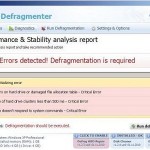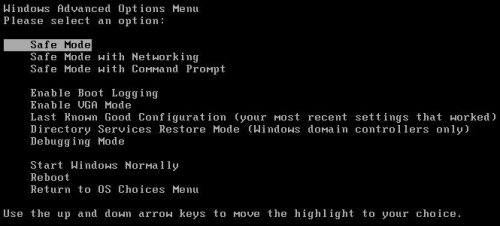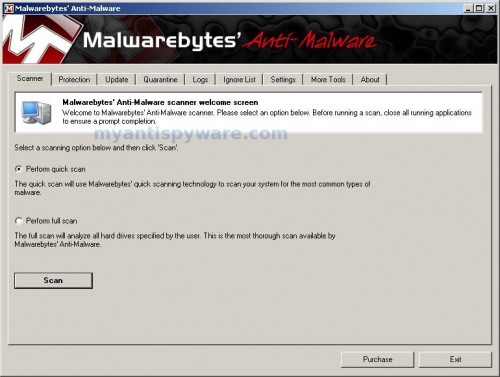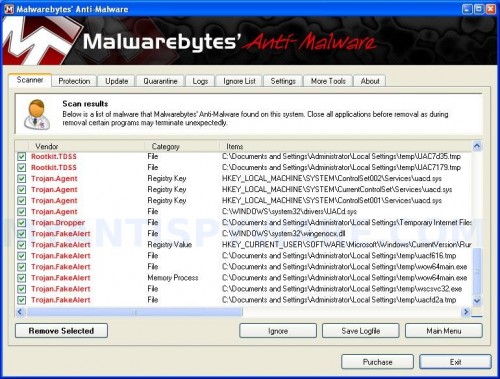 Quick Defragmenter is fake computer optimization application from the same family of malware as HDD Defragmenter, Smart Defragmenter and System Defragmenter. The program detects numerous false system errors, displays a lot of fake system alerts and nag screen, blocks legitimate Windows applications from running. It hopes to scare you into thinking your computer in danger that you will then purchase its full version to fix problems found. Important to note, Quick Defragmenter is a scam, that unable to detect or fix any problems. So do not purchase its paid version! If your PC is already infected you should ignore all that it displays you. Read below what you’ll want to know though is how to remove Quick Defragmenter.
Quick Defragmenter is fake computer optimization application from the same family of malware as HDD Defragmenter, Smart Defragmenter and System Defragmenter. The program detects numerous false system errors, displays a lot of fake system alerts and nag screen, blocks legitimate Windows applications from running. It hopes to scare you into thinking your computer in danger that you will then purchase its full version to fix problems found. Important to note, Quick Defragmenter is a scam, that unable to detect or fix any problems. So do not purchase its paid version! If your PC is already infected you should ignore all that it displays you. Read below what you’ll want to know though is how to remove Quick Defragmenter.
Immediately after launch, Quick Defragmenter will configure itself to run automatically when Windows loads. Once started, the program will imitate a scan of computer`s hard disks, memory, etc and detect numerous critical system errors such “Read time of hard drive clusters less than 500 ms”, “32% of HDD space is unreadable”, “Bad sectors on hard drive or damaged file allocation table”, etc. Of course, all of these errors found are a fake. The misleading application only simulates functions of PC defragmenter software and unable to detect any problems. Quick Defragmenter want to trick you into purchasing its full version. Most important, don`t pay for the bogus program and just ignore the false scan results.
While Quick Defragmenter is running, it will block all legitimate Windows applications from running. The following warning will be shown when you try to run a program:
Windows detected a hard drive problem.
A hard drive error occurred while starting the application.
Moreover, Quick Defragmenter will display numerous fake warnings and nag screens that states:
Windows – No Disk
Exception Processing Message 0×0000013
Critical Error
A critical error has occurred while indexing data stored on hard drive. System restart required.
System Restore
The system has been restored after a critical error. Data integrity and hard drive integrity verification required.
However, all of these warnings are fake and supposed to scare you into thinking your computer is in danger. You should ignore all of them!
If you find that your system is infected with this malware, then most importantly, do not purchase it. Use the removal guide below to remove Quick Defragmenter from your computer for free.
Automated Removal Instructions for Quick Defragmenter
Step 1. Reboot your computer in Safe mode with networking
Restart your computer.
After hearing your computer beep once during startup, start pressing the F8 key on your keyboard. On a computer that is configured for booting to multiple operating systems, you can press the F8 key when the Boot Menu appears.
Instead of Windows loading as normal, Windows Advanced Options menu appears similar to the one below.

Windows Advanced Options menu
When the Windows Advanced Options menu appears, select Safe mode with networking and then press ENTER.
Step 2. Clean temp folder
Quick Defragmenter stores its files in Windows temp foder. You need to clean it.
Please download ATF Cleaner by Atribune from here, saving it to your desktop. It is used to cleanout temporary files & temp areas used by internet browsers.
Start ATF-Cleaner.exe to run the program. Under Main choose: Select All and click the Empty Selected button.
Step 3. Remove Quick Defragmenter and associated malware
Download MalwareBytes Anti-malware (MBAM). Close all programs and Windows on your computer.
Double Click mbam-setup.exe to install the application. When the installation begins, keep following the prompts in order to continue with the installation process. Do not make any changes to default settings and when the program has finished installing, make sure a checkmark is placed next to Update Malwarebytes’ Anti-Malware and Launch Malwarebytes’ Anti-Malware, then click Finish.
If an update is found, it will download and install the latest version.
Once the program has loaded you will see window similar to the one below.

Malwarebytes Anti-Malware Window
Select Perform Quick Scan, then click Scan, it will start scanning your computer for Quick Defragmenter infection. This procedure can take some time, so please be patient.
When the scan is complete, click OK, then Show Results to view the results. You will see a list of infected items similar as shown below. Note: list of infected items may be different than what is shown in the image below.

Malwarebytes Anti-malware, list of infected items
Make sure all entries have a checkmark at their far left and click “Remove Selected” button to remove Quick Defragmenter. MalwareBytes Anti-malware will now remove all of associated Quick Defragmenter files and registry keys and add them to the programs’ quarantine. When MalwareBytes Anti-malware has finished removing the infection, a log will open in Notepad and you may be prompted to Restart.
Quick Defragmenter removal notes
Note 1: if you can not download, install, run or update Malwarebytes Anti-malware, then follow the steps: Malwarebytes won`t install, run or update – How to fix it.
Note 2: if you need help with the instructions, then post your questions in our Spyware Removal forum.
Note 3: your current antispyware and antivirus software let the infection through ? Then you may want to consider purchasing the FULL version of MalwareBytes Anti-malware to protect your computer in the future.
Quick Defragmenter creates the following files and folders
%UserProfile%\Desktop\Quick Defragmenter.lnk
%UserProfile%\Start Menu\Programs\Quick Defragmenter\Quick Defragmenter.lnk
%UserProfile%\Start Menu\Programs\Quick Defragmenter\Uninstall Quick Defragmenter.lnk
%Temp%\{RANDOM}.exe
%Temp%\{RANDOM}
%Temp%\{RANDOM}.dat
Quick Defragmenter creates the following registry keys and values
HKEY_CURRENT_USER\Software\Microsoft\Windows\CurrentVersion\Run | {RANDOM}












I have gone through all the steps and the spyware appears to be gone. The instructions were followed exactly and the results were as you described. However, once the system is rebooted the spyware messages begin to appear. I have tried to go through the process twice and have received the same results. Any suggestions?
Worked like a charm!! love it thanks for this GREAT advice 🙂
Jen, probably your computer is infected with a trojan that reinstalls this malicous tool. Start a new topic in our Spyware removal forum. I will help you to remove this malware.
I removed Quick Defrag with Malwarebytes, but I still cannot go on Internet Explorer or Google Chrome.
Toi, what shows your browser when you trying open any site ?
Thank you, thank you. I followed the directions and the malware is gone. What is especially evil about Quick Defrag is that it tries to con you to spend $70 to remove it. Who knows what they do with your credit card number.